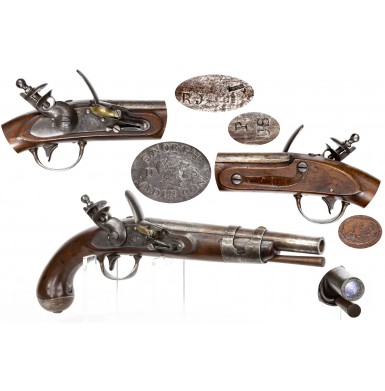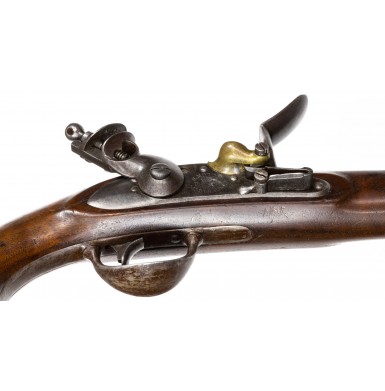Fine US Model 1816 Pistol by Simeon North with Early Style Lock Marking
- Product Code: FHG-C39-SOLD
- Availability: Out Of Stock
-
$2,750.00
The Simeon North produced US Model 1816 Army Contract Flintlock Pistol was the first US martial pistol to be delivered on a truly large scale. Previous US military pistol contracts were typically for fairly small runs of handguns with 2,000 to 3,000 being the typical example of a “large” contract. These contracts were often written for “pairs” of pistols, with 1,000 pairs or 1,500 pairs representing an order for 2,000 or 3,000 guns respectively. From the 1790s through the post-War of 1812 era the typical contract was for no more than about 500 “pairs” of handguns.
The Model 1816 had its genesis in the Simeon North Army Contract Pistol of 1811. That pistol had been contracted for on 18 November 1811 and called for 1,000 pairs of .69 caliber single shot flintlock pistols with pinned barrels and brass furniture. During the production run, it was decided that the pistol should be modified and instead of relying upon pins to secure the barrel to the stock, a double strapped barrel band, secured by a “Wickham’s Improvement” stud was incorporated into the design. The stud was a spring tensioned barrel band retainer that had been designed by Marine T. Wickham. Wickham was initially a US arsenal sub-inspector and later became an arms contractor for the Ordnance Department. The last of the Model 1811 pistols were manufactured in this fashion, and the subsequent model, the Model 1813 pistol also incorporated the double-strapped barrel band and Wickham stud into its design.
The Model 1813 was contracted for on 16 April 1813 and was a direct result of the United States involvement in the War of 1812. The contract called for 10,000 pairs of the pistols (20,000 total) to be manufactured, at the price of $7.00 each. The pistol was an improved version of the earlier Model 1811 with iron furniture but retained the massive .69 caliber bore of its predecessor. This excessively large caliber became problematic almost immediately, and production was temporarily halted in June of 1815 to allow the pistol to be re-designed in .54 caliber. Only 626 of the Model 1813 pistols had been delivered up to this point, and the remaining parts on hand were used to complete a contract of 1,000 .69 pistols for the US Navy, which was designated the US Model 1816 Flintlock Naval Pistol. On 8 January 1816 the original contract for 20,000 pistols was officially renegotiated, and the remaining 19,374 .69 caliber pistols that were due under the 1813 contract were now to be delivered as the newly adopted .54 caliber. The newly redesigned Model of 1813 was redesignated as the US Model 1816 Army Contract Flintlock Pistol, and the guns also had a newly negotiated price of $8.00 each. North undertook to complete the revised contract in a workmanlike fashion and proceeded to deliver the complete contract in about three years’ time, with the final deliveries taking place on 26 January 1820.
The US Model 1816 Army Contract Flintlock Pistol was a large handgun, weighing in at about 3 ¼” pounds and having an overall length of about 15 ¼”. The 9 1/16” long barrel was round with pronounced flats at the breech and with a smooth .54 caliber bore. The barrel is secured to the stock with a screw that passed through the breech plug tang and a double-strapped barrel band with a simple brass blade front sight mounted on the front-most strap. The barrel band was secured to the stock by a Wickham’s Improvement stud. The pistol stock was reinforced with an extended tang that ran from the breech of the pistol to the butt cap, and all of the furniture was of iron. The contract called for all iron parts, with the exception of the lock, to be acid browned. The lock was color casehardened, and was not polished bright, leaving it a dark, bluish black color, but without the brilliant mottling typical of later 19th century case coloring. The lock had a rounded, reinforced cock and an angled brass pan with a bridle, but no fence. The locks were marked with two types of markings, with the early production locks being stamped with a three-line cartouche shaped mark: S. NORTH / U {Eagle} S / MIDLN CON. Later production locks were stamped with a similar mark which read: S. NORTH / U {Eagle} S / MIDLTN CONN. adding the “T” to the abbreviation of “Middleton” and the extra “N” in the abbreviation of “Connecticut”. The pistol was equipped with a hickory ramrod with an iron ferrule on the reverse end that was slotted for use as a cleaning rod, and also threaded to accept implements with male threads for cleaning and ball extraction. The US Model 1816 Army pistol would remain in service with the US military for the next two decades, and although a newer design was adopted in 1819, the Model 1816 pistols were still being issued from US depots well into the mid-1830s for service during the Seminole Wars. The pistols were also issued in large numbers to the various states under the Militia Act of 1808, and state marked examples of these pistols are encountered from time to time. Even though they truly obsolete by the early 1840s and the age of percussion ignition, many US Model 1816 pistols saw new service life during the early days of American Civil War, often with southern arsenal and blacksmith alterations to the percussion system. The many decades of service that these pistols saw, combined the large number of guns that saw hard service as southern conversions during the American Civil War, make these large handguns difficult to find today in crisp condition and in their original flintlock configuration.
This example of a US Model 1816 Army Contract Flintlock Pistol is in about FINE overall condition. The pistol is 100% complete and correct in every way with the exception of the ramrod which is a replacement. The pistol also remains in its original flintlock configuration. The pistol is crisply marked on the lock with the early lock marking:
S. NORTH
U {Eagle} S
MIDLN CON.
suggesting manufacture during the early part of production circa 1817-1818. A very crisp RJ (Robert Johnson) inspection mark is present just above and to the rear of the touchhole. The left breech is deeply marked with a P proof mark and a US ownership mark. The left flat of the stock is marked with a legible script LS acceptance cartouche in an oval, the mark of Springfield Armory sub-inspector Luther Sage. The stock flat is also marked with the bock letter inspection initials J.C, likely the mark of Springfield inspector James Carrington. The stock is also marked with the block inspection initials E.F on the reverse at the tip, inside the double strapped barrel band. The pistol retains some nice traces of original browned finish on the barrel and furniture, with the largest areas of original finish remining on the S-shaped sideplate and triggerguard bow. The barrel and most of the furniture has a streaky brownish-gray appearance with the traces of remaining finish over a smoky gray base metal color. The metal is mostly smooth with some pinpricking and minor erosion around the breech area. There is scattered surface oxidation on the metal surfaces with some freckles of discoloration here and there and some lightly scattered minor roughness. The lock has a dark smoky bluish-gray patina and has some traces of the original blue-black case coloring on the lock. The brass pan has a lovely, untouched ocher patina and shows both old powder residue and green verdigris on its surfaces. The lock is mechanically excellent and functions perfectly on all positions. The lock is 100% original flint and appears to retain all of its original, period parts, with no modern replacements. The smooth bore of the pistol is in about VERY GOOD condition. It is moderately oxidized with discoloration and shows light pitting evenly distributed along its entire length but would likely improve with some cleaning. As mentioned earlier, the ramrod appears is a replacement. It shows some wear and use and may be a period of use replacement. The stock of the pistol rates about NEAR FINE. It is solid and complete with no breaks, cracks or repairs noted. The stock was probably lightly cleaned long ago, and the sharp edges of the counterpane show some rounding and wear. It does not show overt signs of sanding but may have been lightly sanded as well. The cartouche and most of the small inspection marks remain fully legible and relatively clear. The pistol does show the usual scattered bumps, dings and minor handling marks expected of a military pistol, but for a gun that has passed its 200th birthday, the stock remains in really wonderful condition.
Overall, this is a very nice example of a very early American single shot martial pistol in a very nice state of preservation. It retains some nice original finish and remains in original flint without alteration or modification. Only an original ramrod could improve the overall appearance and completeness of the pistol. This is a fine example that is fairly priced and will be a nice addition to any collection of US martial flintlock pistols.
SOLD
Tags: Fine, US, Model, 1816, Pistol, by, Simeon, North, with, Early, Style, Lock, Marking













